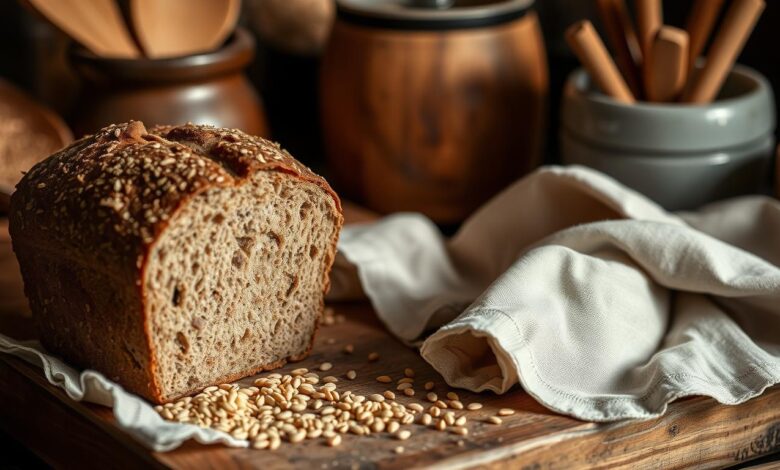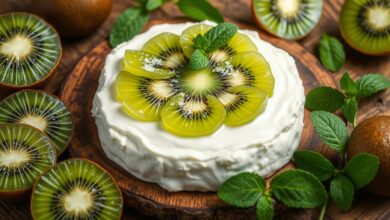Homemade Buckwheat Bread: A Healthy Gluten-Free Choice

There’s nothing like the smell of fresh bread in the kitchen. It’s especially true for those looking for healthier options. Homemade buckwheat bread is a great choice. It’s gluten-free and good for you.
We’ll look at the benefits of buckwheat bread. We’ll also explore its history and how to make it at home. This recipe is perfect for those with gluten issues or anyone wanting to try something new.
Key Takeaways
- Buckwheat bread is a nutritious, gluten-free alternative to traditional wheat bread.
- It is high in fiber, protein, and essential vitamins and minerals.
- Baking homemade buckwheat bread is a rewarding and versatile culinary experience.
- This article will provide a comprehensive guide to the history, ingredients, and step-by-step instructions for making perfect buckwheat bread at home.
- Readers will learn tips and tricks for achieving the perfect texture and rise, as well as creative recipe variations.
Understanding Buckwheat Bread and Its Health Benefits
Buckwheat flour is an ancient grain that’s becoming more popular in baking. It adds a nutty flavor to bread and is very nutritious. Let’s look at why buckwheat bread is a healthy and gluten-free choice.
Key Nutritional Components
Buckwheat flour is packed with dietary fiber, protein, and minerals. It’s not related to wheat and is gluten-free. This makes it great for people with celiac disease or gluten sensitivity. It also has antioxidants and B-vitamins, adding to its health benefits.
Health Advantages of Choosing Buckwheat
- Improved Digestion: The high fiber content in buckwheat bread helps with digestion and regularity.
- Blood Sugar Control: Buckwheat’s low glycemic index helps manage blood sugar and may lower the risk of type 2 diabetes.
- Heart Health: The ancient grains in buckwheat bread are full of antioxidants. They can help lower cholesterol and reduce heart disease risk.
Gluten-Free Properties Explained
Buckwheat bread is gluten-free, making it good for people with celiac disease or gluten-free diets. It doesn’t have gluten, the protein in wheat, rye, and barley. This is good for those with gluten sensitivities.
“Buckwheat flour is a versatile and nutritious ingredient that can transform your baking experience, offering a delightful whole grain alternative to traditional wheat-based breads.”
Essential Ingredients for Perfect Buckwheat Bread
Baking gluten-free bread at home is rewarding. The secret to perfect buckwheat bread is knowing the key ingredients. Let’s look at what makes this artisanal bread so nutritious and tasty.
Buckwheat flour is at the heart of the recipe. It’s a whole grain flour that adds flavor and texture. Plus, it’s gluten-free and full of nutrients, making it great for healthy baking.
Active dry yeast is next. It makes the bread rise and gives it a light texture. A bit of salt enhances the flavor. Water holds everything together, making the dough easy to work with.
Adding seeds or nuts can make the bread even better. Sunflower seeds, pumpkin seeds, or chopped walnuts add crunch and nutrition. They turn the bread into a true artisanal masterpiece.
With these ingredients, you’re ready to bake a gluten-free, nutritious, and flavorful buckwheat bread. It will please your taste buds and support your health goals.
The History and Origins of Buckwheat in Artisanal Baking
Buckwheat is a nutritious grain with a rich history in baking. It comes from Asia and is gluten-free. Skilled bakers use it to make rustic loaves and artisan bread with a unique flavor and texture.
Traditional Uses Across Cultures
In Japan, buckwheat is used to make soba noodles. In Russia, it’s in blinis. In Europe, it’s in sourdough baking, making fermented bread with a nutty taste.
Evolution of Buckwheat Bread Making
The art of buckwheat bread baking has grown over time. Bakers have tried new techniques. They use sourdough starters to make rustic, sourdough baking loaves that highlight buckwheat’s special qualities.
“Buckwheat’s journey from its humble origins to becoming a coveted ingredient in the world of artisanal baking is a testament to the enduring appeal of traditional, fermented bread techniques.”
The love for artisan bread baking and sourdough baking keeps growing. Buckwheat’s role in making fermented bread is as exciting and important as ever.

Step-by-Step Guide to Making Buckwheat Bread
Making buckwheat bread at home is simpler than you think. It’s perfect for those who love a rustic loaf or want to bake healthier. Our guide will help you become a pro at this baking recipes quickly.
Gather Your Ingredients
- 2 cups of buckwheat flour
- 1 teaspoon of salt
- 1 teaspoon of baking powder
- 1 cup of warm water
- 2 tablespoons of honey or maple syrup
- 2 tablespoons of olive oil
Mix and Knead the Dough
In a big bowl, mix buckwheat flour, salt, and baking powder. Add warm water, honey or maple syrup, and olive oil slowly. Keep mixing until it’s a shaggy dough. Then, knead it on a floured surface for 10 minutes. It should be smooth and elastic.
Proof and Shape the Loaf
Put the dough in a greased loaf pan and cover it with a damp towel. Let it proof for 30-45 minutes. It should rise a bit. Then, shape the dough into a smooth, even loaf.
Bake to Perfection
Heat your oven to 375°F (190°C). Bake the buckwheat bread for 30-40 minutes. It’s done when the crust is golden and a toothpick comes out clean. Let it cool before slicing and serving.

This easy guide lets you enjoy buckwheat bread at home. It’s great for classic loaves or rustic bread recipes. This versatile grain is perfect for any artisanal bakery or baking recipes collection.
Tips for Achieving the Perfect Texture and Rise
Baking homemade buckwheat bread can be rewarding but challenging. Getting the perfect texture and rise is key for delicious, fiber-rich bread. We’ll share our top tips to help you overcome common issues and master baking nutritious bread.
Common Challenges and Solutions
One common issue is a dense, heavy texture. This can be due to improper kneading, wrong liquid amounts, or not enough rising time. Here are some solutions:
- Knead the dough well, using the right techniques.
- Adjust the liquid in the recipe, adding more if it’s too dry, or less if it’s too sticky.
- Let the dough rise for the full time, and maybe a bit longer for a lighter texture.
Proper Kneading Techniques
Kneading is vital for making bakery products, especially with gluten-free buckwheat flour. Here are some kneading tips:
- Use a lightly floured surface to prevent sticking.
- Knead for 5-7 minutes, using a gentle yet firm motion.
- Fold the dough over itself, then press it down with your heel, repeating.
- Avoid overworking to prevent a tough, dense texture.
By tackling common challenges and mastering kneading, you’ll make bakery products with great texture and rise. Enjoy baking homemade, fiber-rich bread that will wow your family and friends.

Variations and Creative Recipe Adaptations
Making homemade buckwheat bread opens up a world of possibilities. We can try many creative twists to meet different tastes and needs. Buckwheat flour is great for experimenting because it’s so versatile.
Love herbs and spices? Try adding rosemary, thyme, or cumin to your dough. The buckwheat’s nutty taste goes well with these herbs, making the bread both unique and tasty.
Want a crunchy texture and extra nutrition? Add chopped walnuts, almonds, or sunflower seeds. These add-ins not only make the bread crunchy but also add proteins, fats, and minerals.
Vegans can replace eggs and dairy with plant-based options. Aquafaba from chickpeas works as an egg substitute, and non-dairy milk like almond or oat milk can replace cow’s milk.
For a low-carb option, mix buckwheat flour with ground flaxseed or almond flour. This makes a gluten-free, low-carb loaf that’s great for keto or paleo diets.

There are endless ways to make unique and healthy buckwheat bread. By using fresh herbs, nuts, and other ingredients, we can make a variety of loaves. These loaves meet many dietary needs and tastes.
Storing and Preserving Your Homemade Bread
Baking your own bread is a rewarding experience. Whether it’s a rustic sourdough or a delicious buckwheat loaf, it’s a joy. But, once it cools, keeping it fresh and flavorful becomes a challenge. Don’t worry, we’ve got tips to help your homemade bread stay fresh and tasty.
Best Storage Practices
Storing your homemade bread right is key. For short-term, keep it at room temperature. This could be on the counter or in a bread box. Don’t refrigerate it, as cold air can make it stale and crumbly.
Instead, wrap your loaf in a breathable cloth or paper bag. This helps it keep moisture and a crisp crust.
Freezing and Thawing Methods
- Freezing is best for longer storage. Slice your bread before freezing for easier thawing. Wrap slices tightly in plastic wrap or a resealable bag, removing air.
- To thaw, let slices thaw at room temperature. This gentle thawing keeps the bread’s texture and flavor.
- Or, reheat frozen slices in the oven or toaster. This crisps them up and brings back the fresh-baked taste.
By following these tips, you can enjoy your homemade bread for days or weeks. Happy baking and bon appétit!
Pairing Suggestions and Serving Ideas
Homemade buckwheat bread is a great addition to any meal. It’s a whole grain bread that goes well with many foods. Try it with savory spreads or sweet toppings.
It’s perfect with a hearty soup or stew. Or, top it with creamy avocado, tangy feta, and olive oil for a tasty snack.
For breakfast, toast the bread and add fresh fruit, Greek yogurt, and cinnamon. The bread’s nutty flavor pairs well with fruit. It’s also great for open-faced sandwiches with roasted veggies, grilled chicken, or cheese.
Buckwheat bread is nutritious and good for a healthy diet. Enjoy it as a snack, part of a meal, or on its own. It’s a versatile whole grain bread that will be a favorite in your kitchen.
FAQ
What makes buckwheat bread a healthier choice?
Buckwheat bread is a nutritious, gluten-free option. It’s high in fiber and protein. Made from buckwheat flour, it’s packed with vitamins, minerals, and antioxidants.
Is buckwheat bread suitable for those with gluten sensitivities?
Yes, buckwheat bread is gluten-free. It’s safe for those with celiac disease or gluten intolerance. It doesn’t contain wheat, rye, or barley.
What are the key ingredients needed to make homemade buckwheat bread?
You’ll need buckwheat flour, yeast, salt, and water. Optional ingredients like nuts, seeds, or herbs can add flavor and texture.
How does the history of buckwheat factor into artisanal bread baking?
Buckwheat has been used in breads for centuries, from Asia to Eastern Europe. Modern baking techniques, like sourdough, have evolved its use, creating delicious loaves.
What are some tips for achieving the perfect texture and rise when baking buckwheat bread?
Proper kneading is key for gluten-free bread. Also, let it proof well for a good rise. Overcoming common issues can result in light, airy loaves.
Can I adapt the buckwheat bread recipe to accommodate different dietary needs?
Absolutely! You can modify the recipe for various diets. Try vegan versions, low-carb options, or add extra seeds and nuts for nutrition.
How should I store and preserve my homemade buckwheat bread?
Store it at room temperature, wrapped in a clean towel or paper bag. For longer storage, freeze and thaw as needed.
What are some delicious ways to enjoy buckwheat bread?
Enjoy it toasted with avocado, nut butter, or cheese. It’s also great for open-faced sandwiches or as a healthy snack.



